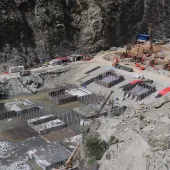Dam collapse raises concerns over RCC
The 14 de Julho dam in Rio Grande do Sul state, southern Brazil, has collapsed following heavy rains and flooding, claiming over 30 lives, with scores more missing.
The dam, part of the CERAN (Energetic Complex of Antas River) on the Antas river, suffered partial failure, raising questions about the integrity of its roller-compacted concrete (RCC) structure.
The complex is comprised of three plants: Monte Claro (130 MW), Castro Alves (130 MW) and 14 de Julho (100 MW), owned by a consortium including Statkraft and CPFL – Geração de Energia.
Constructed in 2006, the 14 de Julho dam, which stands at a maximum height of 42m, utilizes RCC, a method known for its affordability and speed, but which is now facing scrutiny for its vulnerability to extreme weather events, according to local media.
Currently the highest dam of this type is the Gilgel Gibe III Dam in Ethiopia, at 250m, with the Pakistani Diamer-Bhasha Dam under construction at 272m.
Brazilian officials have declared a state of emergency in the region, with severe weather forecasted to persist through May 6. The adverse conditions have already claimed numerous lives, with thousands displaced and widespread infrastructure damage reported.
The tragedy underscores the urgent need for robust construction practices, particularly in the face of increasingly unpredictable weather patterns attributed to climate change.




